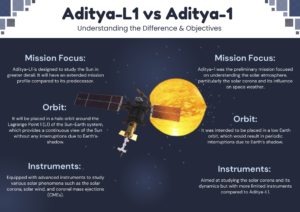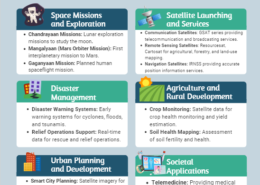The Indian Space Research Organization (ISRO) just launched the Small Satellite Launch Vehicle (SSLV), a brand-new rocket. What benefits does it offer? In what ways might SSLVs transform ISRO in the future? (Answer in 150 words)
Aditya-L1 is a significant advancement over its predecessor, Aditya-1. Here’s how they differ and the scientific objectives of Aditya-L1: Differences Between Aditya-L1 and Aditya-1: Mission Scope and Payloads: Aditya-1: Originally planned to be a dedicated mission to study the solar corona, Aditya-1Read more

Aditya-L1 is a significant advancement over its predecessor, Aditya-1. Here’s how they differ and the scientific objectives of Aditya-L1:
Differences Between Aditya-L1 and Aditya-1:
- Mission Scope and Payloads:
- Aditya-1: Originally planned to be a dedicated mission to study the solar corona, Aditya-1 was designed with a single payload—the Visible Emission Line Coronagraph (VELC). Its primary focus was to capture images of the solar corona and study its dynamics.
- Aditya-L1: Aditya-L1 is an extended and enhanced version of the original mission. It carries multiple payloads to study various aspects of the Sun. While it still includes the VELC, it also incorporates other instruments to observe the solar atmosphere, solar wind, and the impact of solar activity on the Earth’s environment.
- Orbital Position:
- Aditya-1: Planned to be in a low-Earth orbit.
- Aditya-L1: Will be placed in a Lagrange Point 1 (L1) orbit, which is a stable point between the Earth and the Sun. This location provides a continuous view of the Sun without any interference from the Earth or Moon.
- Mission Duration and Coverage:
- Aditya-1: Designed for a limited mission duration and scope.
- Aditya-L1: Aims for a longer mission duration with comprehensive coverage of various solar phenomena due to its strategic position at L1.
Scientific Objectives of Aditya-L1:
- Study of the Solar Corona: To observe the outermost layer of the Sun’s atmosphere and understand its heating mechanisms, solar wind acceleration, and coronal mass ejections.
- Solar Activity and Space Weather: To investigate solar activities such as solar flares and their impact on space weather, including geomagnetic storms and their effects on Earth’s magnetosphere.
- Dynamics of the Solar Atmosphere: To analyze the solar atmosphere’s dynamics and the interactions between different layers, including the photosphere, chromosphere, and corona.
- Solar Wind Studies: To measure the properties of the solar wind and its influence on the Earth’s space environment.
- Connection Between Solar Activity and Geomagnetic Effects: To explore the link between solar phenomena and their effects on the Earth’s magnetic field and ionosphere.
Overall, Aditya-L1 aims to provide a holistic understanding of solar activities and their influence on space weather, which is crucial for predicting space weather events and their potential impact on technological systems and daily life on Earth.
See less


The Small Satellite Launch Vehicle (SSLV) by ISRO offers several advantages and has the potential to be a significant game changer: Advantages of SSLV 1. Cost-Effective Launches:- SSLVs are designed for low-cost access to space, making satellite launches more affordable for smaller companies and eduRead more
The Small Satellite Launch Vehicle (SSLV) by ISRO offers several advantages and has the potential to be a significant game changer:
Advantages of SSLV
1. Cost-Effective Launches:- SSLVs are designed for low-cost access to space, making satellite launches more affordable for smaller companies and educational institutions.
2. Quick Turnaround Time:- SSLVs can be readied for launch in a matter of days, significantly reducing the time between satellite conception and deployment compared to traditional launch vehicles.
3. Flexibility:- SSLVs can be launched on demand, providing greater flexibility in scheduling and reducing dependency on shared payload missions.
4. Simplified Logistics:- The vehicle’s smaller size and modular design simplify the logistics of launch preparation, handling, and transportation.
5. Versatile Payload Capability:- SSLVs can carry a variety of payloads, from small satellites to multiple micro-satellites, offering versatility for different mission requirements.
Potential Impact on ISRO
1. Increased Launch Frequency:- With SSLVs, ISRO can increase the number of launches per year, catering to the growing demand for satellite launches globally.
2. Enhanced Competitiveness:- SSLVs position ISRO as a competitive player in the small satellite launch market, potentially attracting more international clients.
3. Boost to Commercial Space Sector:- The availability of cost-effective and frequent launch options can stimulate growth in the commercial space sector in India and globally.
4. Support for Innovation:- Easier access to space encourages innovation and experimentation, benefiting startups, research institutions, and technology developers.
5. Strategic Autonomy:- Having the capability to launch small satellites independently strengthens India’s strategic autonomy in space operations and satellite-based services.
By providing a reliable, affordable, and flexible launch option, SSLVs can significantly enhance ISRO’s capabilities and contribute to the growth of the global small satellite market.
See less